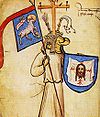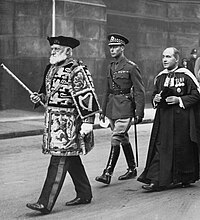Portal:Heraldry
Welcome to the Heraldry and Vexillology Portal!


Vexillology (from the Latin vexillum, a flag or banner) is the scholarly study of flags, including the creation and development of a body of knowledge about flags of all types, their forms and functions, and of scientific theories and principles based on that knowledge. Flags were originally used to assist military coordination on the battlefield, and have evolved into a general tool for signalling and identification, particularly identification of countries.
Heraldry encompasses all of the duties of a herald, including the science and art of designing, displaying, describing and recording coats of arms and badges, as well as the formal ceremonies and laws that regulate the use and inheritance of arms. The origins of heraldry lie in the medieval need to distinguish participants in battles or jousts, whose faces were hidden by steel helmets.
Selected article

Attributed arms are coats of arms given to legendary figures, or to notable persons from times before the rise of heraldry. Beginning in the 12th century, imaginary arms were assigned to the knights of the Round Table, and soon arms were given to biblical figures, to Roman and Greek heroes, and to kings and popes who had not historically borne arms. The specific arms could vary, but the arms for major figures soon became fixed.
Notable arms attributed to biblical figures include the arms of Jesus based on the instruments of the Passion, and the shield of the Trinity. Medieval literature attributed coats of arms to the Nine Worthies, including Alexander the Great, Julius Caesar, and King Arthur. Arms were given to many kings predating heraldry, including Edward the Confessor and William I of England. These attributed arms were sometimes used in practice as quarterings in the arms of their descendants. (more...)
Selected flag

The national flag of Singapore was first adopted in 1959, the year Singapore became self-governing within the British Empire. It was reconfirmed as the national flag when the Republic gained independence on 9 August 1965. The design is a horizontal bicolour of red above white, charged in the canton by a white crescent moon facing, toward the fly, a pentagon of five small white five-pointed stars. The elements of the flag denote a young nation on the ascendant, universal brotherhood and equality, and national ideals.
The national flag is not used as an ensign by vessels at sea. In its place, one of three derivatives of the national flag is used, depending on a vessel's status: merchant vessels and pleasure craft fly a civil ensign of red charged in white with a variant of the crescent and stars emblem in the centre; non-military government vessels such as coast guard ships fly a state ensign of blue with the national flag in the canton, charged with an eight-pointed red and white compass rose in the lower fly; and warships fly a naval ensign similar to the state ensign, but in white with a red compass rose emblem. (more...)
Selected biography

James Robinson Planché (February 27, 1796 – May 30, 1880) was a British dramatist, antiquary and officer of arms. Over a period of almost 60 years he wrote, adapted, or collaborated on 176 plays in a wide range of genres. Planché was responsible for introducing historically accurate costume into nineteenth century British theatre, and subsequently became an acknowledged expert on historical costume, publishing a number of works on the topic.
Planché's interest in historical costume led to other antiquarian research, including heraldry and genealogy. He was elected a Fellow of the Society of Antiquaries in 1829, and was influential in the foundation of the British Archaeological Association in 1843. Appointed Rouge Croix Pursuivant in 1854 and promoted to Somerset Herald in 1866, Planché undertook heraldic and ceremonial duties as a member of the College of Arms including proclaiming peace at the end of the Crimean War and investing foreign monarchs with the Order of the Garter. (more...)
Selected picture

Sir Francis Grant, Lord Lyon King of Arms, HRH The Duke of York, and Rev. Charles Warr proceeding to the Armistice Service at St. Giles' Cathedral, Edinburgh, in 1933.
Did you know...
- ...that, among the flags of Romania, the removal of the socialist coat of arms during the Romanian Revolution of 1989 gave rise to the phrase "the flag with the hole" (pictured)?
- ...that Rodney Dennys left his career in the British intelligence service to become an officer of arms?
- ...that the horseman depicted on the coat of arms of Moscow was not identified with Saint George until the 18th century?
- ...that the flags hoisted by the Finnish icebreaker Tarmo on 3 March 1918 included a large white tablecloth?
- ...that the flag on the top of the Tall Hermann tower on Toompea Hill is one of the best-known symbols in Estonia of the government in power?
Related portals
|
|
|
Heraldry Web resources
Authorities
- Belgium - The Council of Nobility, Flemish Heraldic Council and Council of Heraldry and Vexillology of the French Community
- Canada - Canadian Heraldic Authority and see also Public Register of Arms, Flags and Badges
- England, Wales, and Northern Ireland - The College of Arms
- Ireland - The Office of the Chief Herald of Ireland
- Netherlands - High Council of Nobility
- Portugal - Instituto da Nobreza Portuguesa
- Scotland - The Court of the Lord Lyon
- South Africa - South African Bureau of Heraldry
- Sweden - National Board of Heraldry, The National Archive
- United States Army - The United States Army Institute of Heraldry
Societies
- Greek Heraldry Society
- The Academy of Heraldic Science Czech republic
- The American College of Heraldry
- The American Heraldry Society
- The Augustan Society
- The Australian Heraldry Society Inc.
- Bulgarian Heraldry and Vexillology Society
- The Center for Research of Orthodox Monarchism
- Cambridge University Heraldic and Genealogical Society
- Chiltern Heraldry Group
- The College of Dracology
- Croatian Heraldic and Vexillologic Association
- The Finnish Heraldic Society
- Fryske Rie foar Heraldyk
- Hellenic Armigers Society
- Guild of Heraldic Artists
- Genealogical Society of Ireland
- Heraldry Research Institute (Japan)
- The Heraldry Society
- The Heraldry Society of Africa
- The Heraldry Society of New Zealand Inc.
- The Heraldry Society of Scotland
- The Heraldry Society of Southern Africa
- The Institute of Heraldic and Genealogical Studies
- The International Association of Amateur Heralds
- Italian Center of Vexillological Studies
- Lancashire Heraldry Group
- Macedonian Heraldry Society
- New England Historic Genealogical Society Committee on Heraldry
- Norwegian Heraldry Society
- Oxford University Heraldry Society
- Polish Heraldry Society
- Polish Nobility Confederation
- Real Academia Matritense de Heráldica y Genealogía - Royal Academy of Heraldry and Genealogy of Madrid
- Romanian Institute for Genealogy and Heraldry
- The Royal Heraldry Society of Canada
- The Russian College of HeraldryThe Russian College of Heraldry
- Serbian Heraldic Society
- Societas Heraldica Scandinavica
- Societas Heraldica Slovenica
- Swedish Heraldic Society
- Ukrainian Heraldry Society
- Royal Association Genealogical and Heraldic Office of Belgium
Vexillology
Software
- Coat of Arms Visual Designer web-based program
- Puncher Heraldry Program
- Blazonry Server - pyBlazon
- DrawShield - creates SVG shield or arms image from blazon
- CoaMaker - web-based tool
- Blazon95 and BLAZONS! 2000, older Windows applications
Texts
- Heraldry, historical and popular : with seven hundred illustrations (1863)
- A Complete Guide to Heraldry (1909)
Other
Wikimedia
The following Wikimedia Foundation sister projects provide more on this subject:
-
Commons
Free media repository -
Wikibooks
Free textbooks and manuals -
Wikidata
Free knowledge base -
Wikinews
Free-content news -
Wikiquote
Collection of quotations -
Wikisource
Free-content library -
Wikispecies
Directory of species -
Wikiversity
Free learning tools -
Wikivoyage
Free travel guide -
Wiktionary
Dictionary and thesaurus












